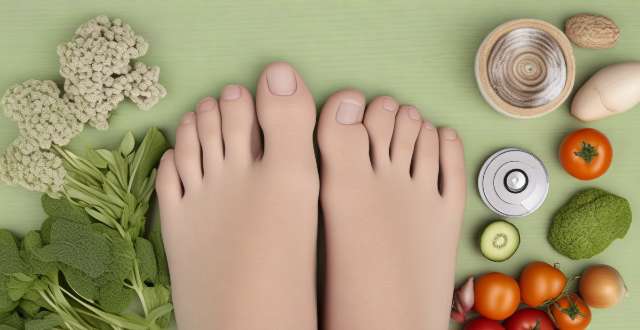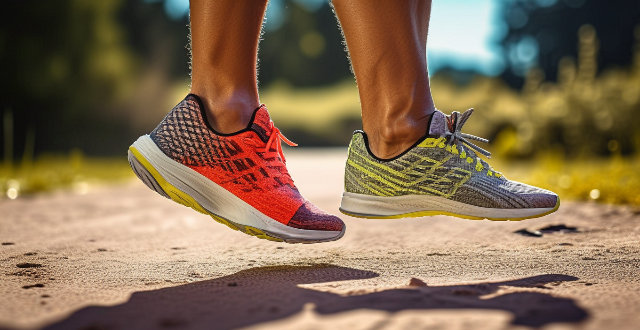Foot Knee

What are some effective ways to prevent knee injuries in sports ?
Knee injuries are common among athletes and can be quite severe, potentially leading to long-term damage or even the end of an athlete's career. There are several effective ways to prevent knee injuries in sports: 1. Proper Warm-Up and Cool-Down: A proper warm-up prepares your body for physical activity by increasing blood flow and warming up muscles. It should include gentle cardio exercises and dynamic stretches that mimic the movements you will perform during your sport. After exercise, gradually reduce your activity level with light stretching and walking to help remove lactic acid from your muscles and prevent stiffness. 2. Wear Appropriate Footwear: Choose shoes specifically designed for your sport that offer adequate support, cushioning, and shock absorption. Replace them regularly as they lose their ability to protect your knees over time. If needed, custom orthotics can provide additional arch support and correct any imbalances in foot alignment. 3. Strengthen Key Muscle Groups: Strong quadriceps help stabilize the patella (kneecap) and protect the knee joint. Exercises like leg presses, squats, and lunges can strengthen these muscles. Flexible hamstrings allow for proper knee extension and flexion during activities like running or jumping. Include hamstring curls and glute bridges in your routine. Strong glutes improve hip stability, which affects knee alignment. Include exercises like hip thrusts and fire hydrants in your workouts. 4. Improve Flexibility and Mobility: Regular static and dynamic stretching can increase flexibility around the knee joint, reducing the risk of injury. Focus on stretching the calves, hamstrings, quadriceps, and IT band. Incorporate mobility drills into your warm-up to improve range of motion at the knee joint. This could include ankle circles, high knees, or butt kicks. 5. Maintain Proper Technique: Ensure that you maintain proper form and alignment during all sports activities. Misaligned movements can place unnecessary stress on the knees. Work with coaches or trainers who can provide feedback on your technique and suggest modifications to reduce strain on your knees. 6. Cross-Train and Rest: Participating in low-impact activities like swimming or cycling can help build overall fitness while reducing repetitive stress on your knees from high-impact sports. Allow sufficient rest days between intense training sessions to give your body time to recover and avoid overuse injuries. 7. Use Supportive Gear When Needed: For athletes with pre-existing knee conditions or those returning from an injury, wearing supportive gear can provide additional stability and protection during activity. Kinesiology tape applied around the kneecap can help reduce pain and improve muscle function by providing subtle cues to the body about proper movement patterns.

What are the consequences of neglecting foot hygiene ?
The text discusses the various consequences of neglecting foot hygiene, including physical health risks such as athlete's foot, toenail fungus, ingrown toenails, blisters and calluses, plantar warts, smelly feet (bromodosis), corns, bunions, gout, cellulitis, diabetic foot ulcers, deep vein thrombosis (DVT), and peripheral neuropathy. It also addresses mental health impacts like embarrassment and self-consciousness, anxiety, and stress. The text provides detailed descriptions and prevention tips for each issue, emphasizing the importance of good foot care habits to maintain overall foot health.

What are some good stretching exercises for after a run ?
After a run, it's important to stretch your muscles to prevent injury and improve flexibility. Here are some good stretching exercises for after a run: - Hamstring Stretch: Sit on the ground with your legs straight out in front of you, reach forward and try to touch your toes without bending your knees, hold for 15-30 seconds and repeat 2-3 times. - Quadriceps Stretch: Stand upright and bend one knee, bringing your heel towards your buttocks, grasp your ankle with one hand and hold onto a stable object with the other hand for balance, pull your foot closer to your buttocks until you feel a stretch in the front of your thigh, hold for 15-30 seconds and repeat 2-3 times on each leg. - Calf Stretch: Stand facing a wall with your hands placed against it at shoulder height, step one foot back behind you, keeping both heels flat on the ground, bend your front knee slightly while keeping your back leg straight, hold for 15-30 seconds and repeat 2-3 times on each leg. - Gluteal Stretch: Sit on the ground with your legs bent and feet flat on the floor, place your right ankle over your left knee, creating a "figure four" shape with your legs, gently push down on your right knee until you feel a stretch in your glutes, hold for 15-30 seconds and repeat 2-3 times on each side.

What are some effective warm-up exercises before starting a run ?
This article emphasizes the importance of warm-up exercises before starting a run. It discusses the benefits of dynamic stretching and light aerobic activities, such as high knees, butt kicks, leg swings, jogging in place, side shuffles, and high knees forward march. It also mentions static stretching as an optional component of warm-up routines, focusing on major muscle groups used during running. Finally, it highlights the necessity of proper cool-down and stretching post-run to aid muscle recovery and reduce soreness.

What are the best stretches for cooling down after a gym session ?
After a gym session, it's crucial to gradually cool down your body. Here are the best stretches for that: hamstring, quadriceps, calf, hip flexor, and back stretches. These exercises help reduce heart rate, lower blood pressure, prevent muscle soreness, improve flexibility, and range of motion. Remember to hold each stretch for at least 30 seconds and avoid bouncing to prevent injury.

How important is footwear when it comes to running techniques ?
Footwear plays a crucial role in running techniques, improving performance and reducing the risk of injuries. Proper footwear should provide cushioning, support, fit, comfort, traction, grip, breathability, and durability. To choose the right pair of running shoes, consider your foot type (neutral, flat, or high arches), running style (heel striker, midfoot striker, or forefoot striker), terrain (road or trail), and distance. Try before you buy to ensure proper fit and comfort.

What are the best exercises for sports recovery ?
The text discusses the importance of sports recovery and suggests various exercises to aid in this process. The exercises include stretching, foam rolling, light cardiovascular exercise, and yoga. Stretching helps increase blood flow, reduce muscle tension, and improve flexibility. Foam rolling relieves muscle tightness and soreness by applying pressure to specific areas of the body. Light cardiovascular exercise increases blood flow and promotes recovery. Yoga improves flexibility, reduces stress, and promotes relaxation while also improving balance and stability. The author suggests several specific exercises for each category to help athletes recover from their workouts or competitions.

How can I select the right pair of ski boots ?
Ski boots are an essential piece of equipment for any skier. Here are some tips to help you choose the perfect ski boots: 1. Determine your skiing ability level. 2. Consider your foot type. 3. Look for proper fit and comfort. 4. Check for proper support and control. 5. Try before you buy. 6. Consider customization options.

How can I incorporate stretching into my daily office routine ?
Incorporating stretching into a daily office routine is crucial for maintaining good posture, preventing muscle stiffness, and reducing the risk of work-related injuries. Here are some tips to help you add stretching to your daily routine: Start with a warm-up: Begin your day with simple warm-up exercises like shoulder shrugs, arm circles, and neck rolls. Take breaks to stretch: Set an alarm or use a timer app to remind yourself to take short breaks throughout the day to stretch your wrists, back, and legs. Use your lunch break wisely: Take advantage of your lunch break to do a more comprehensive stretching session. Find a quiet space where you won't be disturbed and stretch your hamstrings, quads, and calves. End your day with cool-down stretches: Before leaving the office, take a few minutes to cool down and stretch out any tight muscles that have developed during the day. Stretch your chest, hip flexors, and shoulders. Remember to listen to your body and only stretch to the point of mild discomfort. Never force a stretch or bounce, as this can lead to injury. By incorporating these simple stretching exercises into your daily office routine, you'll improve your overall well-being and increase productivity at work.

What are the best exercises for a full-body workout at home ?
A full-body workout at home is an excellent way to maintain your fitness levels without the need for a gym membership or equipment. Here are some of the best exercises that you can do at home to get a comprehensive workout: 1\. Squats: Stand with your feet shoulder-width apart and your arms straight out in front of you, then lower your body by bending at the knees and hips until your thighs are parallel to the ground. Pause for a moment, then push through your heels to return to the starting position. Repeat this movement for 10-15 repetitions. 2\. Lunges: Stand with your feet hip-width apart and take a big step forward with one foot, then lower your body until both knees are bent at 90-degree angles. Keep your front knee directly over your ankle and your back knee hovering just above the ground, then push off with your front leg to return to the starting position. Repeat this movement for 10-15 repetitions on each leg. 3\. Push-Ups: Start in a plank position with your hands shoulder-width apart and your feet together, then lower your body until your chest nearly touches the ground. Push through your palms to return to the starting position. Repeat this movement for 10-15 repetitions. 4\. Plank: Start in a push-up position with your hands shoulder-width apart and your feet together, then lower your forearms to the ground so that your elbows are directly under your shoulders. Hold your body in a straight line from head to heels for 30 seconds to a minute. Repeat this movement for 3-5 sets. 5\. Burpees: Start standing with your feet shoulder-width apart and your arms at your sides, then lower your body into a squat position and place your hands on the ground in front of you. Jump both feet back into a plank position, perform a push-up, jump both feet forward so they land outside of your hands, stand up and jump into the air with your arms overhead. Repeat this movement for 10-15 repetitions.